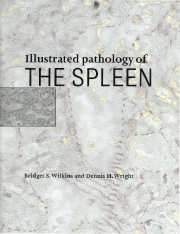Book contents
- Frontmatter
- Contents
- Preface
- Acknowledgements
- 1 Introduction
- 2 Normal structure, development and functions of the spleen
- 3 Post-traumatic and incidentally removed spleens
- 4 The spleen in hereditary blood cell abnormalities and auto-immune disorders
- 5 The spleen in immunodeficiency and systemic infections
- 6 Lymphomas involving the spleen
- 7 The spleen in myeloproliferative disorders
- 8 Pathology of the splenic stroma
- 9 Metastases and miscellaneous conditions
- 10 Summary: some key points in splenic differential diagnosis
- Index
7 - The spleen in myeloproliferative disorders
Published online by Cambridge University Press: 14 August 2009
- Frontmatter
- Contents
- Preface
- Acknowledgements
- 1 Introduction
- 2 Normal structure, development and functions of the spleen
- 3 Post-traumatic and incidentally removed spleens
- 4 The spleen in hereditary blood cell abnormalities and auto-immune disorders
- 5 The spleen in immunodeficiency and systemic infections
- 6 Lymphomas involving the spleen
- 7 The spleen in myeloproliferative disorders
- 8 Pathology of the splenic stroma
- 9 Metastases and miscellaneous conditions
- 10 Summary: some key points in splenic differential diagnosis
- Index
Summary
Splenic extramedullary haemopoiesis
Different forms of splenic extramedullary haemopoiesis have different significance
The occurrence of significant splenic extramedullary haemopoiesis (EMH) as a normal process in human fetal life is questionable (see Chapter 2), but there is no doubt that small foci of EMH are common incidental findings in the liver and spleen throughout post-natal life. Such foci are generally of no clinical significance. They usually consist of clusters of nucleated erythroid cells within sinusoids. Single, apparently mature, megakaryocytes may also be seen in these tissues but it is doubtful whether these should be regarded as representing haemopoiesis. Megakaryocytes are known to enter the circulation and lodge in small vessels at a variety of sites around the body (including the lungs) as part of their normal, mature behaviour. Pathologists must be able to recognize such incidental examples of extramedullary haemopoietic cell location so that they do not mistake them for any significant abnormality.
Splenic EMH is significant when it occurs as a manifestation of a myeloproliferative disorder or leukaemia, or secondary to bone marrow replacement by fibrosis or metastasis. Under these circumstances, EMH preferentially involves the spleen, with or without detectable involvement of the liver. The spleen is usually enlarged (sometimes massively) and the underlying diagnosis may already be known from a bone marrow biopsy. Splenectomy is usually performed for relief of symptoms (abdominal mass, pain and/or hypersplenism) in these patients rather than for diagnostic purposes.
- Type
- Chapter
- Information
- Illustrated Pathology of the Spleen , pp. 111 - 124Publisher: Cambridge University PressPrint publication year: 2000
- 1
- Cited by



